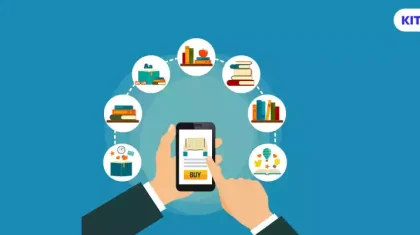
Empowering Education: The Need for Robust Platforms to Deliver Instructional Materials
Summarize this blog with your favorite AI:
The COVID-19 pandemic has forever changed the way we approach education. What was once a temporary solution to a global crisis has now become the future of learning. From K-12 students to corporate employees, individuals across the world are embracing online learning for its flexibility, affordability, and proven ability to enhance knowledge retention.
In fact, by 2029, online learning is projected to reach 1.0 billion users , a testament to its growing influence in the educational landscape. As this shift continues, the demand for powerful, reliable platforms to deliver high-quality instructional material is more urgent than ever.
In this article, we’ll explore the vital role that robust digital platforms play in shaping the future of education. We’ll delve into the key features and benefits that are transforming the learning experience and empowering students to take control of their educational journeys.
Table of Contents:
I. Characteristics of Instructional Delivery Platforms
II. Benefits of Digital Content Delivery Systems for Education
- Self-Paced Learning
- Content Personalization
- Quick and Constant Access to Information
- Enhanced Accessibility
- Real-Time Tracking and Analysis
- Collaborative Learning
- Cost Effectiveness and Sustainability
- Improved Teacher Efficiency
III. Summing Up
Characteristics of Instructional Delivery Platforms
The top five characteristics of digital platforms include:
1. Interactive Elements
A good digital platform must include interactive elements like audio files, quizzes, simulations, animations, and more to keep the learners creatively engaged. It also helps keep them motivated and improve learning retention.
2. Customization and Flexibility
Features of digital platforms like micro-modules, adaptive learning pathways, and customizable lesson plans offer both customizable and flexible learning. This allows learners to learn at their own pace and access the course material independently. Moreover, learners can also opt for accelerated learning modules if they are willing to devote more time per week.
3. Security and Privacy
With the increasing reliance on digital platforms, safeguarding user data is paramount. A secure platform instills confidence among users and ensures compliance with legal regulations.
4. Gamification
Unlike traditional learning, gamified learning can foster a higher level of engagement and motivation in learners.
As a result, numerous digital platforms are adopting gamified elements to enhance learning and retention. Games can stimulate real-life scenarios to help learners develop 21st-century skills like creativity, collaboration, decision-making, and more.
5. Accessibility
The platform should be inclusive, catering to diverse learners regardless of geographic location, economic background, or physical abilities. Features like offline access, multilingual support, and compatibility with low-bandwidth environments are essential.
Benefits of Digital Content Delivery Systems for Education
The top eight benefits of learning through digital platforms include:
1. Self-Paced Learning
Without deadlines stipulated by an instructor or teachers, digital learning platforms allow learners to take charge of their learning journey by covering lessons at their own pace.
It also allows them the freedom to spend longer or shorter periods engaging with challenging course material. Self-directed learning can also greatly improve self-regulation and time management.
2. Content Personalization
In traditional classroom learning, it becomes challenging for the instructor to customize instructional material to cater to each student’s diverse learning needs.
However, with classroom instructional tools offered by digital platforms, teachers can deliver personalized content to each student and enhance learning outcomes. Assessments and take-home activities can also be personalized to focus on learning areas requiring improvement.
3. Quick and Constant Access to Information
With digital platforms, students need not rely solely on their instructors and teachers to provide learning content.
On the learning platform, they have 24/7 access to learning materials as well as other resources like mock tests, sample question papers, and more. Additionally, these platforms prove to be reliable gateways to join learning communities and collaborate with learners from other geographical locations and educational backgrounds.
4. Enhanced Accessibility
Robust platforms break down geographical and economic barriers to education. Students in remote areas or underserved communities can access quality resources that were previously out of reach. For instance, platforms with offline capabilities ensure uninterrupted learning even in regions with limited internet connectivity.
Digital textbook platforms like KITABOO further enhance accessibility by providing learners with flexible access to materials anytime, anywhere—ensuring that education is never limited by location or infrastructure.
5. Real-Time Tracking and Analysis
Almost all digital platforms allow instructors and educators to track and assess student performance.
An in-depth performance analysis and learning analytics give them a clear understanding of how well the learning content is working to boost the academic performance of each student. The content can then be optimized accordingly, leading to improved content absorption and engagement.
6. Collaborative Learning
Students frequently feel more at ease studying in groups with their peers, where they can discuss the challenges and interesting topics they encountered in their learning journey.
Digital learning, which facilitates collaborative learning, can accomplish this. Students can participate in online study groups and exchange information to expand their area of study.
7. Cost Effectiveness and Sustainability
Adopting digital learning can help with sustainability and cost-effectiveness. In addition to saving money, less reliance on tangible resources like paper and textbooks supports eco-friendly learning systems. Digital learning also removes geographical restrictions, increasing access to high-quality education without requiring complex infrastructure.
8. Improved Teacher Efficiency
Digital platforms also aid educators and instructors by simplifying their teaching process. Features like AI lesson planning, automated grading, and performance analytics allow educators to focus on their primary role: teaching. Additionally, access to a vast repository of resources enables teachers to enhance their instructional methods.
Summing Up
It is safe to say that adopting digital platform learning can offer learners and educators many opportunities.
Accessibility, interactive elements, collaborative learning, etc., can offer immersive learning experiences and foster improved retention and engagement. There are numerous software programs for instructional materials to leverage the full potential of digital learning.
KITABOO is a top digital textbook platform that empowers educators and students to create, access, and distribute immersive learning materials securely and at scale. With features designed to enhance content delivery and engage learners, KITABOO meets the evolving needs of modern education.
Don’t miss out on the benefits of digital learning. Contact us today to schedule a demo and discover how KITABOO can help you build a dynamic, future-ready learning environment.
Also check:
Discover how a mobile-first training platform can help your organization.
KITABOO is a cloud-based platform to create, deliver & track mobile-first interactive training content.


